
IHMC’s Nadia Is a Versatile Humanoid Teammate
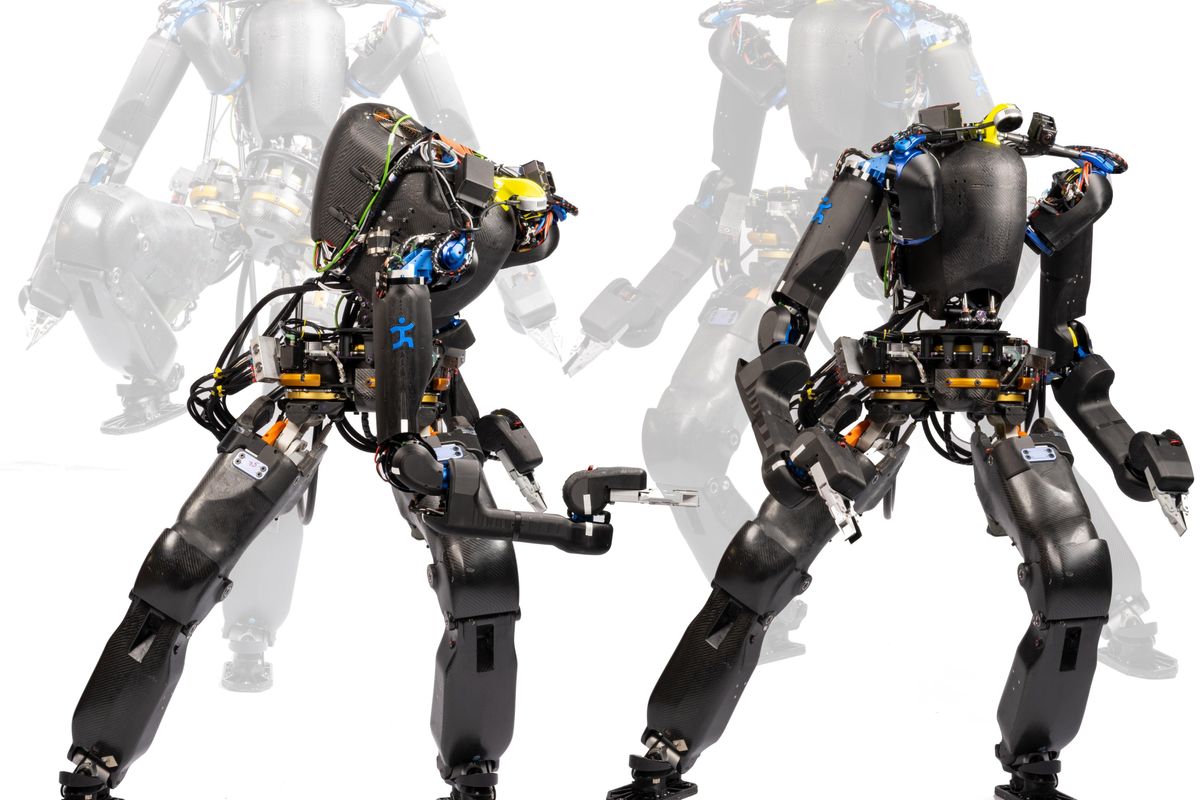
The Florida Institute for Human & Device Cognition (IHMC) is very well recognised in bipedal robotics circles for teaching quite sophisticated humanoid robots to wander. Due to the fact 2015, IHMC has been dwelling to a Boston Dynamics Atlas (the DRC model) as well as a NASA Valkyrie, and sizeable development has been designed on advancing these platforms toward trustworthy mobility and manipulation. But basically, we’re conversing about some pretty aged hardware in this article. And there just are not a great deal of excellent replacement selections (readily available to scientists, anyway) when it arrives to humanoids with human-similar power, velocity, and flexibility.
Many decades back, IHMC made the decision that it was large time to construct its possess robotic from scratch, and in 2019, we saw some really interesting plastic concepts of Nadia—a humanoid designed from the floor up to carry out practical jobs at human speed in human environments. Just after 16 (!) experimental plastic versions, Nadia is now a actual robot, and it previously seems to be rather spectacular.
For a extended time, we’ve been pushing up versus the limitations of the hardware with DRC Atlas and Valkyrie. We haven’t been ready to entirely explore the limitations of our software program and our controls. With Nadia, it’s the other way about, which is genuinely remarkable from a investigation point of view.
—Robert Griffin, IHMC
Developed to be fundamentally the upcoming technology of the DRC Atlas and Valkyrie, Nadia is more rapidly, a lot more flexible, and strong sufficient to make an great investigate system. It’s a hybrid of electric powered and hydraulic actuators: 7 levels-of-liberty (DoF) electric arms and a 3 DoF electric pelvis, coupled with a 2 DoF hydraulic torso and 5 DoF hydraulic legs. The hydraulics are built-in good actuators, which we have coated in the earlier. Nadia’s joints have been arranged to improve assortment of movement, this means that it has a dense manipulation workspace in front of by itself (the place it really issues) as very well as extremely cellular legs. Carbon fiber shells masking most of the robotic allow for for harmless make contact with with the surroundings.
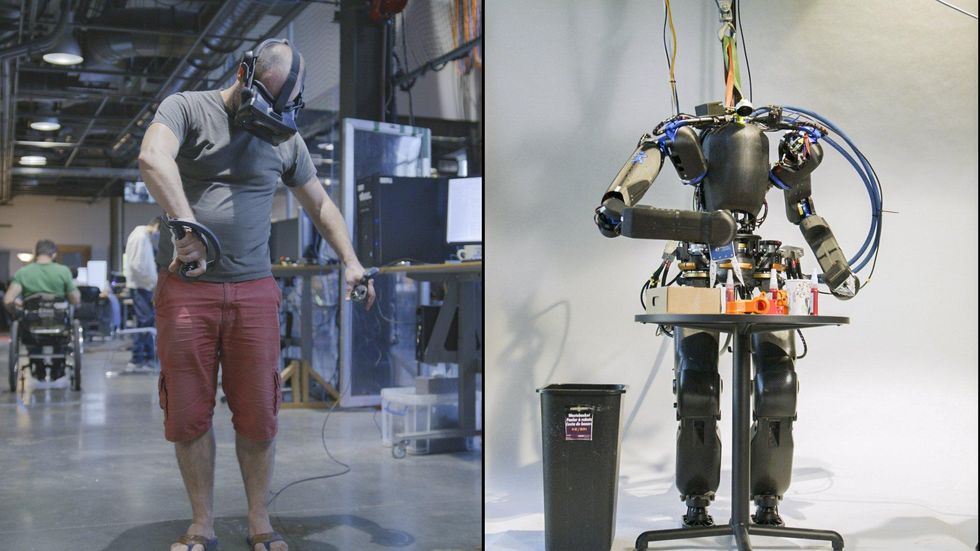
Teleoperation through immersive virtual truth helps Nadia carry out sophisticated tasks.IHMC
That substantial manipulation workspace is specially appropriate since there’s a lot of emphasis on immersive digital reality teleoperation with Nadia. Not that autonomy is not critical, but the idea behind Nadia has been formed (at least in part) by IHMC’s encounter at the DARPA Robotics Obstacle Finals: Ideally, you want the robot to take care of all the things it can on its own, while obtaining a human ready to get extra immediate management about advanced jobs. While it’s not the fantasy of a robot becoming absolutely autonomous, the reality is that in the in the vicinity of phrase, this technique is an promptly feasible way of having robots to reliably do valuable issues in unstructured environments. All round, the objective with Nadia is to operate as close to human pace as achievable when undertaking urban exploration and manipulation duties. And if that requires a human right teleoperating the robot due to the fact that is the best way of accomplishing factors, Nadia is developed to deal with it.
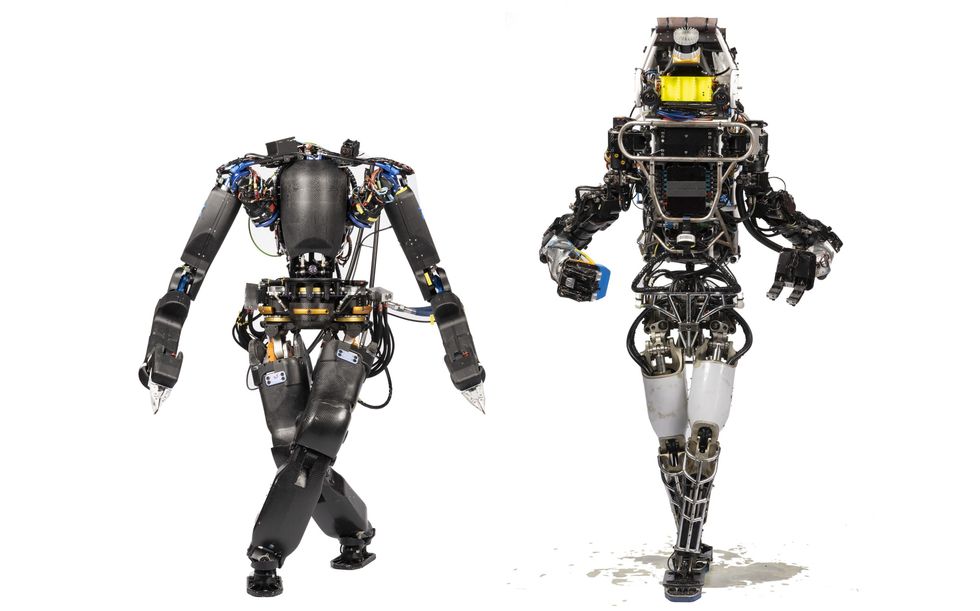
Nadia demonstrates how considerably much more versatile its hips and legs are relative to DRC Atlas.IHMC
For a lot more aspects about Nadia, we spoke with Robert Griffin, a research scientist at IHMC.
How is Nadia distinctive between humanoid robots?
Robert Griffin: I think the big matter that we’re seeking to deliver to the desk with Nadia is the genuinely high variety of movement of a lot of the joints. And it is not just the assortment of movement that differentiates Nadia from several other humanoid robots out there, it’s also speed and electrical power. Nadia has significantly much better power-to-weight than the DRC Atlas, making it significantly a lot quicker, which enhances its basic operational velocity as perfectly as its security.
Can you put your targets with Nadia into context in the humanoid robotics room?
Griffin: We’re trying to make Nadia a robotic that can purpose in unstructured environments the place you really do not know what it requires to do ahead of time. So, as an alternative of getting a set sequence or range of duties, we’re trying to construct up a robot in components, application, and interfaces that enable a human-machine crew to go into an unidentified natural environment, take a look at it, map it, and then do meaningful responsibilities.
IHMC has a standing for assisting advanced humanoid robots like DRC Atlas and Valkyrie with their mobility. How has all of that expertise designed its way into Nadia’s style?
Griffin: You’re proper, and we have been partnering with NASA JSC considering that the DRC—when you see Valkyrie walking now, it’s making use of IHMC program and controllers. When it will come to applying some of that knowledge to Nadia, we have compensated specific notice to matters like Nadia’s range of motion in its legs. Unlike a lot of humanoid platforms, Nadia has really fantastic hip roll (or ab/adduction), which indicates that it can do really broad methods and also definitely narrow techniques wherever the ft overlap every other. We assume that is heading to assistance maximize mobility by supporting with move adjustment and reaching hard footholds.
Outside of the hardware, we had been also able to use our simulation instruments and control stack to definitely aid us specify what the hardware design and style essential to be in order to attain some of these duties. We weren’t able to enhance all of the joints on the robot—we quite much caught with a one hydraulic piston in the legs, for now, but we hope that our long term patterns will be far better built-in and optimized. We do have whole ankle actuation, as opposed to a lot of humanoid robots. Our solution, from the commencing, was to glance for the important management authority with Nadia’s toes to be equipped to do specific foot placement, and use that for relatively quick reactive mobility.
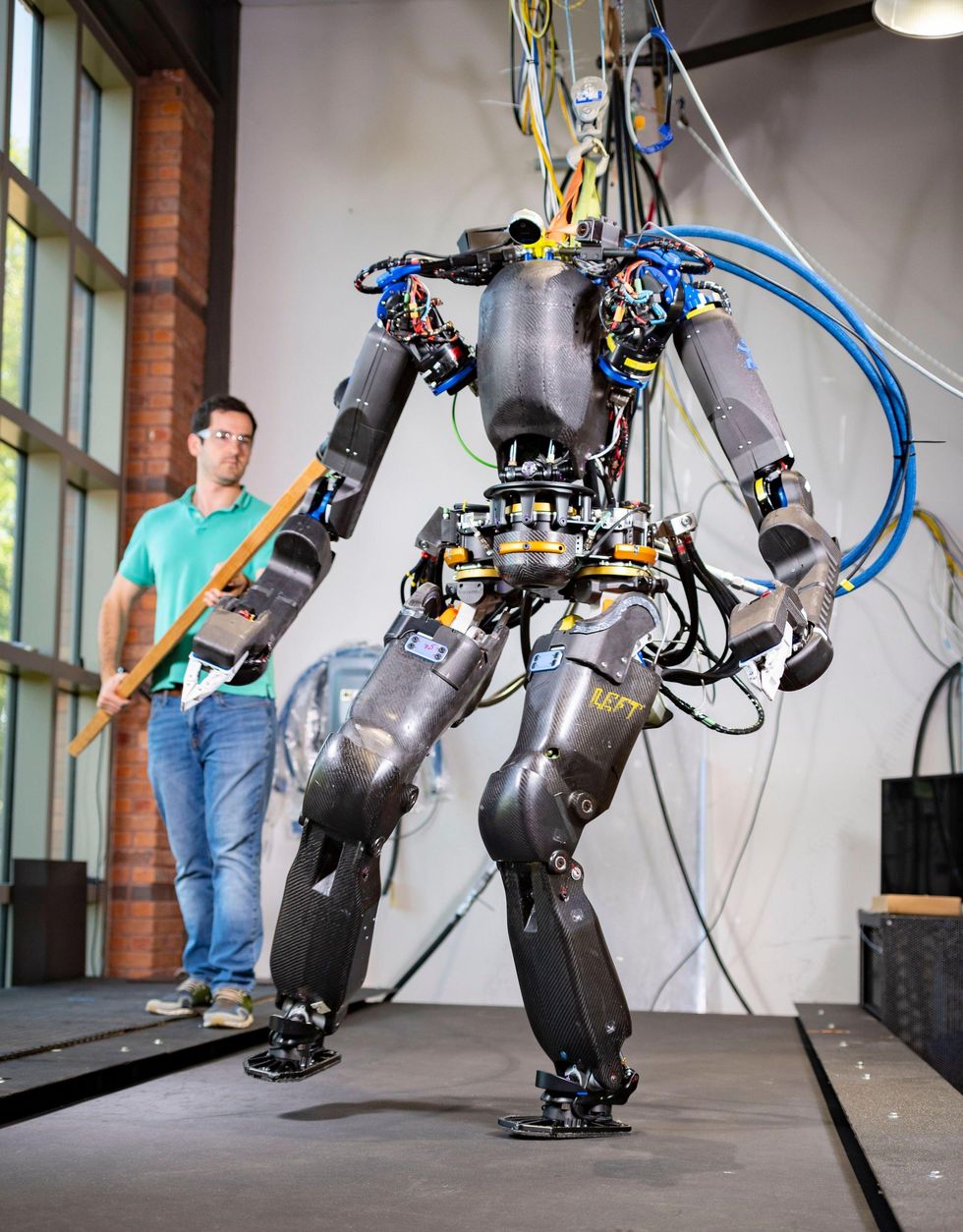
Robert Griffin gives Nadia a handy shove, for science.IHMC
As you went from concept to components with Nadia, what compromises did you have to make?
Griffin: We’re not really as adaptable as a common human, even though we’re not very much off. I was amazed that we lost some selection of motion in the mechanisms just due to the fact of the hydraulic hose routing, in particular close to the hips, wherever we needed to prevent owning major loops of hoses hanging off the robotic. We sooner or later want to just take Nadia into the actual globe, and we really do not want the hoses having snagged on factors.
Nadia is not really as rapidly as a human in some of the joints, and in some of the joints it is quicker. We’re also not really as compact as we desired to be initially, because, well, robots are seriously difficult. We’re hoping to get it a minimal more compact in the foreseeable future. And we missed our body weight margin by a tiny bit—it’s about 90 kilograms ideal now, without having the hydraulic pump or battery on board.
Why did you decide to focus on how a human can right regulate Nadia in VR, as opposed to extra emphasis on autonomy?
Griffin: Autonomy works truly, truly well when you know what the working conditions are, and what you’re attempting to complete. Not that it’s straightforward to automate that, but it’s feasible. We have experimented with some autonomous setting up and manipulation, and we identified that it is a minimal restricting in that it does not get benefit of the entire abilities of our platform. And so what we’re searching at performing is attempting to automate just important components of the system—things like footstep planning and grasp arranging, which can be automatic fairly nicely. But we also need the ability to interact with novel environments, which is why we’re focusing on establishing techniques to crew with humans by means of interfaces like virtual fact. With the cognitive abilities of a human combined with the manipulation capabilities of the robotic, we believe you get a ton of flexibility.
How substantially of a variance has it designed to managing Nadia in VR, that the components has humanlike overall flexibility and a humanlike workspace?
Griffin: For manipulation, it’s been large. We do not want the person to be operating the robotic and experience like they’re confined in what they can do simply because of the robot’s constraints. A great deal of the manipulation that we’ve been ready to do with Nadia we could never ever have carried out with our other platforms.
There are absolutely trade-offs—the arms are much more made for velocity than for power, which is likely to be a very little bit limiting, but we’re hoping to enhance that prolonged-phrase. I believe that building the robot—and specifically the command process and program architecture—with the concept of getting a human running it has opened up a large amount of capability that we hope will permit us fast iterate together lots of diverse paths.
What are some items that Nadia will be uniquely able of?
Griffin: We’re hoping that the robotic will be uniquely able of multicontact locomotion—that’s a path that we’re genuinely hoping to go in, where by we’re not just relying on our toes to shift via the earth. But I never always want to say that it’ll be improved at that than other robots are, simply because I do not know everything that other robots can do.
Are there functional responsibilities that you hope Nadia will be capable to do at some place in the long run?
Griffin: Items like catastrophe response, nuclear remediation, bomb disposal—these responsibilities are mainly finished by men and women correct now, due to the fact we never have robots that are truly capable of executing them sufficiently irrespective of the total of time that roboticists have been working on it. I assume that by partnering excellent robotic engineering with truly amazing running interfaces and human cognition, these responsibilities will begin to become possible to do by a robotic.
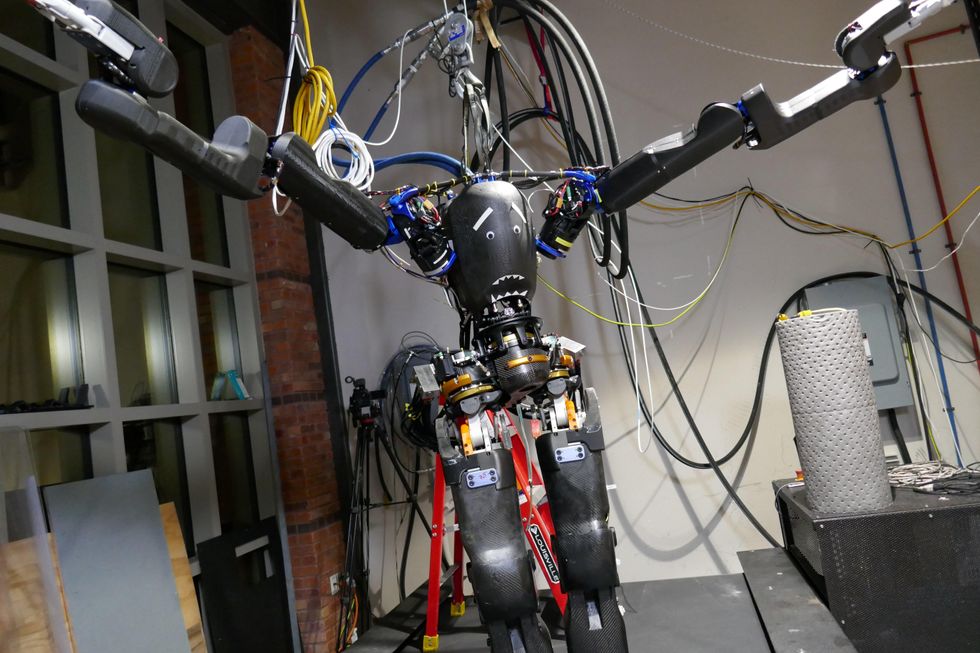
Who needs a real head when you have googly eyes and a shark mouth?IHMC
Even although Nadia is manufacturer new, IHMC presently has a bunch of updates planned for the robotic. The most evident a single is slicing that tether by placing batteries and a tailor made hydraulic pump into Nadia’s torso. Also on the road map are better torque arms and lighter, additional streamlined legs. In the meantime, the program has a lot of catching up to do to allow Nadia to reach its whole opportunity. And if we know IHMC, that is heading to be an unbelievably thrilling factor to see.
